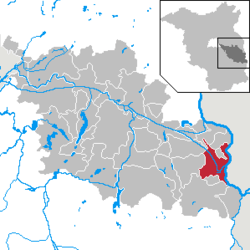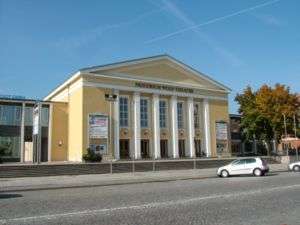Eisenhüttenstadt
| Eisenhüttenstadt | ||
|---|---|---|
|
View over Eisenhüttenstadt | ||
| ||
 Eisenhüttenstadt | ||
Location of Eisenhüttenstadt within Oder-Spree district  | ||
| Coordinates: 52°08′42″N 14°40′22″E / 52.14500°N 14.67278°ECoordinates: 52°08′42″N 14°40′22″E / 52.14500°N 14.67278°E | ||
| Country | Germany | |
| State | Brandenburg | |
| District | Oder-Spree | |
| Government | ||
| • Mayor | Dagmar Püschel (The Left) | |
| Area | ||
| • Total | 63.40 km2 (24.48 sq mi) | |
| Population (2015-12-31)[1] | ||
| • Total | 30,416 | |
| • Density | 480/km2 (1,200/sq mi) | |
| Time zone | CET/CEST (UTC+1/+2) | |
| Postal codes | 15890 | |
| Dialling codes | 03364 | |
| Vehicle registration | LOS | |
| Website | www.eisenhuettenstadt.de | |
Eisenhüttenstadt (literally "ironworks city" in German; [ʔaɪznˈhʏtnʃtat]; Polish: Żelazowa Huta; Lower Sorbian: Pśibrjog) is a town in the Oder-Spree district of the state of Brandenburg, Germany, on the border with Poland. It had a population of 32,214 as of 31 December 2008.
History
The town was founded in 1950 (under the name Stalinstadt) alongside a new steel mill as a socialist model city. A few years before the town was established, its territory was linked to Kłopot, Poland, by a bridge over the Oder River, but the link was destroyed by retreating German forces in February 1945, near the end of World War II. The population grew rapidly in the 1950s and 1960s. In 1961, during De-Stalinization, the town was renamed Eisenhüttenstadt. After German reunification in 1990, the state-owned steel works were privatized, and most of its 12,000 employees lost their jobs. The factory currently employs around 2,500 workers.[2] The town experienced a steep decline in population, from just over 50,000 to under 30,000 today.
Demographics
-

Development of Population since 1875 within the Current Boundaries (Blue Line: Population; Dotted Line: Comparison to Population Development of Brandenburg state; Grey Background: Time of Nazi rule; Red Background: Time of Communist rule)
-

Recent Population Development (Blue Line) and Forecasts


Architecture
The first design for the new residential quarter was developed by the modernist and Bauhaus architect, Franz Ehrlich, in August 1950. His modernist plan, which laid out a dispersed town landscape along functional lines, was rejected by the Ministry for Reconstruction. The same happened to the plan presented by the architects Kurt Junghanns and Otto Geiler. The plan that was ultimately realized was developed by Kurt Walter Leucht.[3][4]
International Relations
The town is twinned with:
Notable people
Eisenhüttenstadt was the birthplace of:
- Bernhard Lösener (1890-1952), jurist
- Udo Beyer (born 1955), shot put, Olympian champion 1976 and holder of world record
- Hans-Georg Beyer (born 1956), handball player, olympic winner 1980
- Detlef Gerstenberg (1957–1993), hammer thrower, competitor in 1980 Summer Olympics
- Frank Schaffer (born 1958), athlete, medal winner in 1980 Summer Olympics
- Katharina Bullin (born 1959), volleyball player
- Gisela Beyer (born 1960), athlete
- Hendrik Reiher (born 1962), rowing cox, medal winner in multiple Olympic Games
- Torsten René Gutsche (born 1968), sprint canoer, competitor in two Summer Olympic Games; 1992 winner of the Bambi Award
- Sven Helbig (born 1968), producer, musician
- Kathrin Boron (born 1969), sculler, competitor in multiple Olympic Games, gold medalist in several World Rowing Championships
- Sören Lausberg (born 1969), retired track cyclist, competitor in two Summer Olympic Games
- Paul van Dyk (born 1971), DJ, composer and music producer
- Amadeus Wallschläger (born 1985), soccer player
- Roger Kluge (born 1986), racing cyclist, silver medal winner in 2008 Summer Olympic Games
- Florian Müller (born 1986), soccer player
Other personalities associated with the city
- Rudolf Bahro (1935-1997), regime critics and author of the book The alternative. To the critique of the existing socialism. , spent his school days in the city
- Tamara Bunke (1937-1967), fellow combatant of Che Guevara in Bolivia, made here the abitur
- Rolf Henrich (born 1944), lawyer, first signatory of the Founding Call of the New Forum
- Tom Hanks visited the city in 2011, creating much free publicity for the city.[5]
References
- ↑ "Bevölkerung im Land Brandenburg nach amtsfreien Gemeinden, Ämtern und Gemeinden 31. Dezember 2015 (Fortgeschriebene amtliche Einwohnerzahlen auf Grundlage des Zensus 2011)". Amt für Statistik Berlin-Brandenburg (in German). 2016.
- ↑ Emily Young (28 April 2014). "Germany: The rise and fall of a model socialist city". BBC News. Retrieved 28 April 2014.
- ↑ BernhFalter.pmd
- ↑ http://www.eisenhuettenstadt.de/cgi-bin/main.php?d1cnr=517
- ↑ http://www.dw.com/en/eisenhüttenstadt-tom-hanks-kind-of-place/a-15842082
External links
| Wikimedia Commons has media related to Eisenhüttenstadt. |

